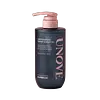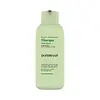What's inside
What's inside
 Key Ingredients
Key Ingredients

 Benefits
Benefits

 Concerns
Concerns

 Ingredients Side-by-side
Ingredients Side-by-side

Water
Skin ConditioningSodium Laureth Sulfate
CleansingAmmonium Lauryl Sulfate
CleansingCocamidopropyl Betaine
CleansingDipropylene Glycol
HumectantParfum
MaskingPPG-3 Myristyl Ether
EmollientSodium Benzoate
MaskingPolyquaternium-10
Sodium Chloride
MaskingCaprylyl Glycol
EmollientCitric Acid
BufferingHydroxypropyl Guar Hydroxypropyltrimonium Chloride
Hexyl Cinnamal
PerfumingPhenoxyethanol
PreservativePentasodium Pentetate
Sodium Carbonate
BufferingLimonene
PerfumingCitronellol
PerfumingGeraniol
PerfumingHydrolyzed Milk Protein
Skin ConditioningHydrolyzed Collagen
EmollientButylene Glycol
Humectant1,2-Hexanediol
Skin ConditioningHydrolyzed Silk
HumectantMentha Piperita Leaf Extract
Skin ConditioningChamomilla Recutita Flower Extract
MaskingMonarda Didyma Leaf Extract
Skin ConditioningRosmarinus Officinalis Leaf Extract
AntimicrobialFreesia Refracta Extract
Skin ConditioningLavandula Angustifolia Extract
Skin ConditioningHydrolyzed Keratin
HumectantEthyl Hexanediol
SolventSilk Amino Acids
HumectantEthylhexylglycerin
Skin ConditioningCamellia Japonica Seed Oil
EmollientOlea Europaea Fruit Oil
MaskingArgania Spinosa Kernel Oil
EmollientMacadamia Integrifolia Seed Oil
Skin ConditioningHelianthus Annuus Seed Oil
EmollientHydrolyzed Corn Protein
Skin ConditioningHydrolyzed Soy Protein
HumectantHydrolyzed Wheat Protein
Skin ConditioningLeucine
Skin ConditioningTaurine
BufferingIsoleucine
Skin ConditioningValine
MaskingAspartic Acid
MaskingOrnithine
Skin ConditioningGlutamic Acid
HumectantGlycine
BufferingGlutamine
Skin ConditioningCystine
MaskingMethionine
Skin ConditioningTyrosine
MaskingLysine
Skin ConditioningAlanine
MaskingPhenylalanine
MaskingSerine
MaskingTryptophan
MaskingThreonine
Arginine
MaskingHistidine
HumectantAsparagine
MaskingProline
Skin ConditioningWater, Sodium Laureth Sulfate, Ammonium Lauryl Sulfate, Cocamidopropyl Betaine, Dipropylene Glycol, Parfum, PPG-3 Myristyl Ether, Sodium Benzoate, Polyquaternium-10, Sodium Chloride, Caprylyl Glycol, Citric Acid, Hydroxypropyl Guar Hydroxypropyltrimonium Chloride, Hexyl Cinnamal, Phenoxyethanol, Pentasodium Pentetate, Sodium Carbonate, Limonene, Citronellol, Geraniol, Hydrolyzed Milk Protein, Hydrolyzed Collagen, Butylene Glycol, 1,2-Hexanediol, Hydrolyzed Silk, Mentha Piperita Leaf Extract, Chamomilla Recutita Flower Extract, Monarda Didyma Leaf Extract, Rosmarinus Officinalis Leaf Extract, Freesia Refracta Extract, Lavandula Angustifolia Extract, Hydrolyzed Keratin, Ethyl Hexanediol, Silk Amino Acids, Ethylhexylglycerin, Camellia Japonica Seed Oil, Olea Europaea Fruit Oil, Argania Spinosa Kernel Oil, Macadamia Integrifolia Seed Oil, Helianthus Annuus Seed Oil, Hydrolyzed Corn Protein, Hydrolyzed Soy Protein, Hydrolyzed Wheat Protein, Leucine, Taurine, Isoleucine, Valine, Aspartic Acid, Ornithine, Glutamic Acid, Glycine, Glutamine, Cystine, Methionine, Tyrosine, Lysine, Alanine, Phenylalanine, Serine, Tryptophan, Threonine, Arginine, Histidine, Asparagine, Proline
Water
Skin ConditioningGlycerin
HumectantCaprylic/Capric Triglyceride
MaskingCetearyl Alcohol
EmollientBehentrimonium Methosulfate
Stearamidopropyl Dimethylamine
EmulsifyingGlyceryl Stearate
EmollientBambusa Vulgaris Water
Skin ConditioningCetyl Alcohol
EmollientQuaternium-33
Stearyl Alcohol
EmollientCitrus Limon Peel Oil
MaskingCitric Acid
BufferingPropanediol
SolventGuar Hydroxypropyltrimonium Chloride
Skin ConditioningCitrus Aurantium Dulcis Peel Oil
MaskingButylene Glycol
HumectantPolyquaternium-10
Eucalyptus Dives Leaf Oil
PerfumingCaprylyl Glycol
EmollientLanolin Acid
CleansingDisodium EDTA
Citrus Aurantifolia Oil
CleansingCamellia Oleifera Seed Oil
Skin ConditioningEthylhexylglycerin
Skin Conditioning1,2-Hexanediol
Skin ConditioningIllicium Verum Fruit/Seed Oil
MaskingMacadamia Ternifolia Seed Oil
EmollientOlea Europaea Fruit Oil
MaskingSimmondsia Chinensis Seed Oil
EmollientArgania Spinosa Kernel Oil
EmollientCarum Carvi Seed Oil
MaskingPersea Gratissima Oil
Skin ConditioningPhlox Drummondii Seed Extract
Skin ConditioningHydrolyzed Cranberry Fruit/Leaf Extract
Skin ProtectingSalvia Officinalis Leaf Extract
CleansingSodium Citrate
BufferingVegetable Oil
Skin ConditioningCamellia Sinensis Flower Extract
PerfumingTocopherol
AntioxidantAlgin
MaskingCitral
PerfumingLimonene
PerfumingWater, Glycerin, Caprylic/Capric Triglyceride, Cetearyl Alcohol, Behentrimonium Methosulfate, Stearamidopropyl Dimethylamine, Glyceryl Stearate, Bambusa Vulgaris Water, Cetyl Alcohol, Quaternium-33, Stearyl Alcohol, Citrus Limon Peel Oil, Citric Acid, Propanediol, Guar Hydroxypropyltrimonium Chloride, Citrus Aurantium Dulcis Peel Oil, Butylene Glycol, Polyquaternium-10, Eucalyptus Dives Leaf Oil, Caprylyl Glycol, Lanolin Acid, Disodium EDTA, Citrus Aurantifolia Oil, Camellia Oleifera Seed Oil, Ethylhexylglycerin, 1,2-Hexanediol, Illicium Verum Fruit/Seed Oil, Macadamia Ternifolia Seed Oil, Olea Europaea Fruit Oil, Simmondsia Chinensis Seed Oil, Argania Spinosa Kernel Oil, Carum Carvi Seed Oil, Persea Gratissima Oil, Phlox Drummondii Seed Extract, Hydrolyzed Cranberry Fruit/Leaf Extract, Salvia Officinalis Leaf Extract, Sodium Citrate, Vegetable Oil, Camellia Sinensis Flower Extract, Tocopherol, Algin, Citral, Limonene
Ingredients Explained
These ingredients are found in both products.
Ingredients higher up in an ingredient list are typically present in a larger amount.
1,2-Hexanediol is a synthetic liquid and another multi-functional powerhouse.
It is a:
- Humectant, drawing moisture into the skin
- Emollient, helping to soften skin
- Solvent, dispersing and stabilizing formulas
- Preservative booster, enhancing the antimicrobial activity of other preservatives
You may know this ingredient as argan oil. Argan Oil has antioxidant, hydrating, and soothing properties.
Studies have shown argan oil can help fight again radical damage from the sun. This makes it effective at preventing hyperpigmentation.
Large amounts of vitamin E found in argan oil helps the skin retain water. Argan oil also contains fatty acids such as linoleic acid, oleic acid, and palmitic acid. It is also a good source of lipids.
Another benefit of argan oil is skin-soothing. It can help reduce inflammation-related skin symptoms.
Argan Oil is effective at regulating sebum production in pores. This can make it effective at treating hormonal acne.
Traditionally, argan oil was used for its antibacterial and antifungal properties. However, argan oil contains fatty acids that may make it not fungal-acne safe.
Argan Trees are native to Morocco.
Learn more about Argania Spinosa Kernel OilButylene Glycol (or BG) is used within cosmetic products for a few different reasons:
Overall, Butylene Glycol is a safe and well-rounded ingredient that works well with other ingredients.
Though this ingredient works well with most skin types, some people with sensitive skin may experience a reaction such as allergic rashes, closed comedones, or itchiness.
Learn more about Butylene GlycolCaprylyl Glycol is a humectant and emollient, meaning it attracts and preserves moisture.
It is a common ingredient in many products, especially those designed to hydrate skin. The primary benefits are retaining moisture, skin softening, and promoting a healthy skin barrier.
Though Caprylyl Glycol is an alcohol derived from fatty acids, it is not the kind that can dry out skin.
This ingredient is also used as a preservative to extend the life of products. It has slight antimicrobial properties.
Learn more about Caprylyl GlycolCitric Acid is an alpha hydroxy acid (AHA) naturally found in citrus fruits like oranges, lemons, and limes.
Like other AHAs, citric acid can exfoliate skin by breaking down the bonds that hold dead skin cells together. This helps reveal smoother and brighter skin underneath.
However, this exfoliating effect only happens at high concentrations (20%) which can be hard to find in cosmetic products.
Due to this, citric acid is usually included in small amounts as a pH adjuster. This helps keep products slightly more acidic and compatible with skin's natural pH.
In skincare formulas, citric acid can:
While it can provide some skin benefits, research shows lactic acid and glycolic acid are generally more effective and less irritating exfoliants.
Most citric acid used in skincare today is made by fermenting sugars (usually from molasses). This synthetic version is identical to the natural citrus form but easier to stabilize and use in formulations.
Read more about some other popular AHA's here:
Learn more about Citric AcidEthylhexylglycerin (we can't pronounce this either) is commonly used as a preservative and skin softener. It is derived from glyceryl.
You might see Ethylhexylglycerin often paired with other preservatives such as phenoxyethanol. Ethylhexylglycerin has been found to increase the effectiveness of these other preservatives.
Limonene is a fragrance that adds scent and taste to a formulation.
It's found in the peel oil of citrus fruits and other plants such as lavender and eucalyptus. The scent of limonene is generally described as "sweet citrus".
Limonene acts as an antioxidant, meaning it helps neutralize free radicals.
When exposed to air, oxidized limonene may sensitize the skin. Because of this, limonene is often avoided by people with sensitive skin.
The term 'fragrance' is not regulated in many countries. In many cases, it is up to the brand to define this term. For instance, many brands choose to label themselves as "fragrance-free" because they are not using synthetic fragrances. However, their products may still contain ingredients such as essential oils that are considered a fragrance.
Learn more about LimoneneOlea Europaea Fruit Oil is the fixed oil obtained from the ripe fruit of the Olive. In other words - olive oil.
The primary contents of olive oil are glycerides of the fatty acids linoleic, oleic and palmitic.
Olive oil also contains antioxidants such as Vitamin E. Antioxidants may help reduce signs of aging by fighting unstable free-radical molecules. It also contains Vitamins A (retinol), D, and K.
The squalene in olive oil makes it a great emollient. Emollients help soothe and soften your skin by trapping moisture in. This makes olive oil a great skin moisturizer.
Studies show olive oil to have antibacterial and antifungal properties in low concentrations. Another study found olive oil irritated sensitive oily skin. We always recommend speaking with a professional about using this ingredient in your routine.
Due to the fatty acid content, this ingredient may not be fungal-acne safe.
Learn more about Olea Europaea Fruit OilPolyquaternium-10 is an ammonium salt of hydroxyethylcellulose. It is a white and granular powder used as a film-former and anti-static agent.
This ingredient is commonly found in hair conditioning products. According to a manufacturer, its positive charge makes it great for absorbing hair proteins. The manufacturer also states this ingredient helps with curl retention.
For haircare friends: this ingredient is not a silicone.
Learn more about Polyquaternium-10Water. It's the most common cosmetic ingredient of all. You'll usually see it at the top of ingredient lists, meaning that it makes up the largest part of the product.
So why is it so popular? Water most often acts as a solvent - this means that it helps dissolve other ingredients into the formulation.
You'll also recognize water as that liquid we all need to stay alive. If you see this, drink a glass of water. Stay hydrated!
Learn more about Water